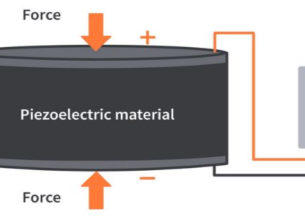Piezoelectric Effect
Why in News?
- Scientists have recently reported evidence of the Piezoelectric effect in liquids.
Highlights
- The piezoelectric effect is a phenomenon in which certain materials produce an electrical charge in response to mechanical stress or pressure. This effect occurs when the material is subjected to a force that causes its molecules to become polarized, meaning that the positive and negative charges within the material are separated from each other.
- When this polarization occurs, an electric potential is generated across the material, and if the material is connected to a circuit, a current can flow.
- The reverse is also true: if an electric potential is applied to the material, it can cause a mechanical deformation.
- Piezoelectric materials are used in a variety of applications, such as in sensors, actuators, and energy harvesting devices. Some examples of common piezoelectric materials include quartz, ceramics, and certain types of crystals.
- Example: Quartz is the most famous piezoelectric crystal: it is used in this capacity in analog wristwatches and clocks.
- The Piezoelectric effect was discovered in 1880, in quartz, by Jacques and Pierre Curie.
- The discovery opens the door to applications that have previously not been accessible with solid-state materials and are more readily recyclable and in many instances pose fewer environmental issues than many currently used piezoelectric materials.
- The liquids also displayed the inverse piezoelectric effect: they became distorted when an electric charge was applied, this fact could be used to control how the liquids bent light passing through them by passing different currents through them.
- That is, using this simple control mechanism, vials of these liquids could be lenses with dynamic focusing abilities.
- The new finding challenges the theory that describes this effect as well as opens the door to previously unanticipated applications in electronic and mechanical systems







